
This article relates to the flora of New Zealand, especially indigenous strains. New Zealand's geographical isolation has meant the country has developed a unique variety of native flora. However, human migration has led to the importation of many other plants as well as widespread damage to the indigenous flora, especially after the advent of European colonisation, due to the combined efforts of farmers and specialised societies dedicated to importing European plants & animals.

Lygodium is a genus of about 40 species of ferns, native to tropical regions across the world, with a few temperate species in eastern Asia and eastern North America. It is the sole genus in the family Lygodiaceae in the Pteridophyte Phylogeny Group classification of 2016. Alternatively, the genus may be placed as the only genus in the subfamily Lygodioideae of a more broadly defined family Schizaeaceae, the family placement used in Plants of the World Online as of November 2019.

Onoclea is a genus of plants in the family Onocleaceae, native to moist habitats in eastern Asia and eastern North America. They are deciduous ferns with sterile fronds arising from creeping rhizomes in spring, dying down at first frost. Fertile fronds appear in late summer. Depending on the authority, the genus contains one to five species.
Water fern is a common name for several plants and may refer to:
Parablechnum monomorphum, synonym Blechnum monomorphum is a species of fern in the family Blechnaceae. It is native to Colombia (Antioquia), Ecuador and Bolivia.
Blechnum sociale is a species of fern in the family Blechnaceae. It is endemic to Pichincha Province and Azuay Province, Ecuador, but has not been recorded since 1893. The name sociale indicates that they form in colonies. It was first described by Sodiro in 1883. In 1893, Sodiro transferred it to Lomaria as Lomaria socialis. He said that the most similar species was Lomaria stipitellata, now placed in Parablechnum as Parablechnum stipitellatum. The status and taxonomy of Blechnum sociale was unclear as of 2003.
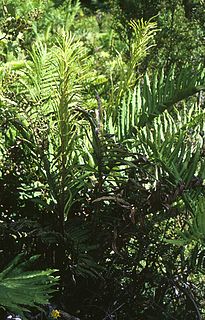
Parablechnum cordatum, the Chilean hard fern or costilla de vaca, is a fern of the family Blechnaceae, native to Chile. It is also found in neighboring areas of Argentina and the Juan Fernández Islands.
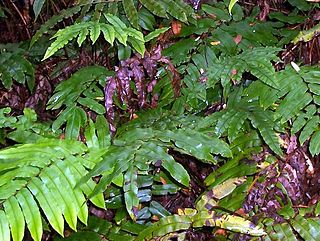
Parablechnum wattsii, synonym Blechnum wattsii, is a common terrestrial fern growing in rainforest and open forest. It is often seen near creeks in much of south eastern Australia, including Victoria, Tasmania, South Australia, New South Wales and Queensland. The specific epithet wattsii honours William Walter Watts (1856-1920). Watts was considered an authority on mosses and ferns and has more than 30 species named for him. Common names by which the species may be called are hard water fern - from its stiff leathery fronds, leech fern - as forest workers often encounter leaches while working in clusters of these ferns, hard hill fern - from the fern's habit and habitat, and red cabbage fern - from the bronze-pink colour of the young fronds resembling cooked red cabbage.

Parablechnum ambiguum, synonym Blechnum ambiguum, is a species of fern in the family Blechnaceae. growing on wet rocks in eastern Australia, often seen near waterfalls. It is common around Sydney.

Angiopteris evecta, commonly known as the king fern, giant fern, elephant fern, oriental vessel fern, Madagascar tree fern, or mule's Foot fern, is a very large rainforest fern in the family Marattiaceae native to most parts of Southeast Asia and Oceania. It has a history dating back about 300 million years, and is believed to have the longest fronds of any fern in the world.
Victoria, Australia contains approximately 32,000 hectares of temperate rainforest in various regions, which represents 0.14% of the State's total area. The areas with rainforest include: East Gippsland, Strzelecki Ranges, Wilsons Promontory, Central Highlands, and Otway Ranges. The rainforests vary between cool temperate, warm temperate, and mixed cool temperate.

Parablechnum minus, synonym Blechnum minus, is a small fern growing in moist situations in a variety of habitats in eastern Australia. It is often seen by streams.
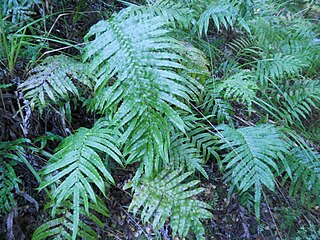
Parablechnum novae-zelandiae, synonym Blechnum novae-zelandiae, commonly known as palm-leaf fern or kiokio, is a species of fern found in New Zealand. It can often be found growing in clay soil on embankments and roadsides.

Parablechnum howeanum, synonym Blechnum howeanum, is a fern in the family Blechnaceae. The specific epithet refers to the locality to which it is endemic.
Tasmania is home to 'Australia’s largest cool temperate rainforests... Most of Tasmania’s rainforests occur in the North-West and throughout the North East highlands. Cool temperate rainforests typically have a heavy rainfall, cool climate, favor high altitudes and have a limited availability of light.

Parablechnum gregsonii, synonym Blechnum gregsonii, is a type of fern, mostly seen in the Illawarra and Blue Mountains areas of eastern Australia, often near waterfalls and moist gullies.
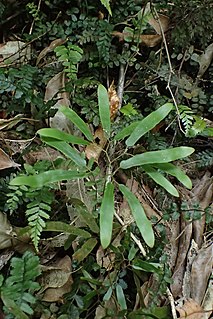
Lygodium articulatum, commonly referred to as mangemange or Bushman's mattress, is a fern endemic to the North Island forests of New Zealand. Mangemange is an endemic species and is unique compared to other ferns in the area due to the vine–like curtain it creates in the canopy. Although the majority of the plant is found in the canopy of the surrounding forest, the roots and stem of mangemange form on the ground, meaning it cannot be classified as an epiphyte.
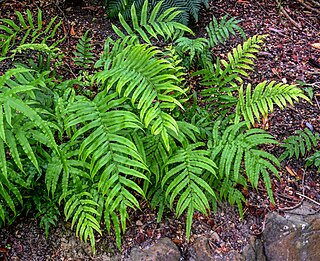
Parablechnum is a genus of ferns in the family Blechnaceae, subfamily Blechnoideae, according to the Pteridophyte Phylogeny Group classification of 2016. The genus is accepted in a 2016 classification of the family Blechnaceae, but other sources sink it into a very broadly defined Blechnum, equivalent to the whole of the PPG I subfamily.
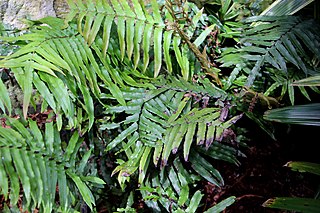
Parablechnum camfieldii, synonym Blechnum camfieldii is known as the eared swamp fern. Often found near saline areas, or low-lying coastal sites in eastern Australia. The new growth is often pink in colour. Named after Julius Henry Camfield (Wd), a gardener at the Royal Botanic Gardens, Sydney.














